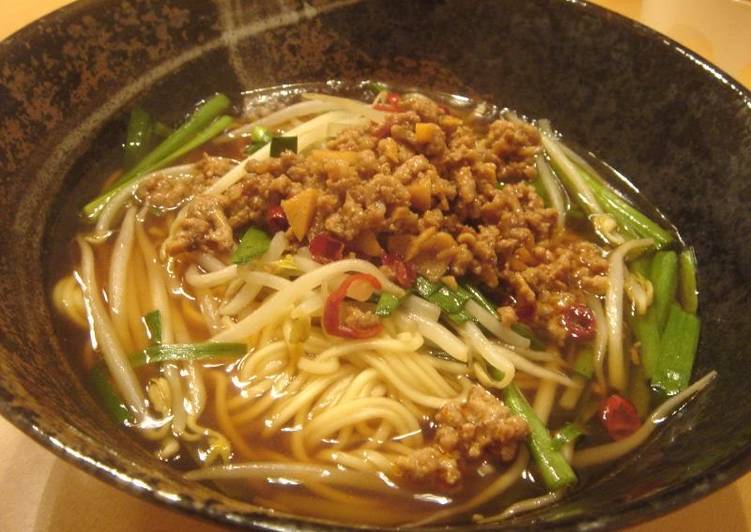
Hello everybody, it’s Louise, welcome to my recipe site. Today, I’m gonna show you how to make a special dish, a nagoya speciality misen-style taiwanese ramen. It is one of my favorites. This time, I will make it a bit unique. This is gonna smell and look delicious.
A Nagoya Speciality Misen-Style Taiwanese Ramen is one of the most popular of current trending foods on earth. It’s simple, it’s quick, it tastes yummy. It is enjoyed by millions daily. A Nagoya Speciality Misen-Style Taiwanese Ramen is something which I have loved my whole life. They are nice and they look wonderful.
Boil water in a separate pot for cooking the noodles. Now, Taiwan ramen can be eaten at many restaurants mainly in Nagoya. But it is born in Misen. The birthplace of Taiwan ramen is Misen !
To get started with this particular recipe, we have to prepare a few components. You can cook a nagoya speciality misen-style taiwanese ramen using 7 ingredients and 7 steps. Here is how you can achieve that.
The ingredients needed to make A Nagoya Speciality Misen-Style Taiwanese Ramen:
- Make ready 100 grams Ground pork
- Take 2 clove Garlice (homemade pickled garlic with soy sauce)
- Get 5 Red chili peppers
- Make ready 2 tsp Doubanjiang
- Take 1/2 bag Bean sprouts
- Make ready 1/2 bag Chinese chives
- Prepare 2 portions Store-bought soy sauce flavoured ramen noodles
Their Taiwan Ramen is garlicky using lots of red chili pepper, but that makes the noodle soup addictive. <Today's Menu/今日の献立> ・Taiwan Ramen MISEN style (Very hot ramen with seasoned meat and too much garlic) ・Sauteed green leafy vegetables with garlic ・Hot Chick. After leaving Nagoya, I wanted to be able to experience the taste of Misen Ramen, so I looked into how to make it. Adjust the spiciness to your liking. For the ramen, I recommend uncooked fresh ramen with soup packets, but instant ramen is.
Instructions to make A Nagoya Speciality Misen-Style Taiwanese Ramen:
- Roughly mince the garlic. Remove seeds from the red hot peppers. (You don't have to remove them completely.) Chop them into small rounds. Wash the bean sprouts. Wash the Chinese chives, and chop into 5 cm lengths.
- Pour a little bit of vegetable oil in a wok, and stir-fry the garlic, half of red chili peppers, and Doubanjiang.
- When fragrant, add the ground meat. When the colour of the meat changes, add the 1 tablespoon of soy sauce from the pickled garlic. Turn off the heat, and transfer to a plate.
- Please don't wash the wok from Step 2. Add the instructed amount of water on the package. I used 500 ml of water for 2 servings this time, and remaining red hot peppers, then turn on the heat.
- When the water from Step 4 starts to boil, add the sauce for the soup, and bring to a boil again, then turn off the heat. (Usually you have to turn off the heat before adding the sauce.)
- Boil water in a separate pot for cooking the noodles. When you add the noodles in boiling water, simultaneously add the bean sprouts to the Step 5 pot, and turn on the heat. Add the Chinese chives to the soup 30 seconds before the noodles are ready.
- Drain the noodles, pour the Step 6 soup over, and add the Step 3 meat on top, then done.
Adjust the spiciness to your liking. For the ramen, I recommend uncooked fresh ramen with soup packets, but instant ramen is. It's a kind of Chinese noodle with ground pork, Chinese chives, green onions and bean sprouts that are seasoned hot with red peppers and other spices and placed on boiled ramen noodles in a soy sauce-based soup. Many of Chinese restaurants in Nagoya have this kind of ramen on their menus. Originally from Nagoya, they brought their specialty Taiwan Ramen with them.
So that is going to wrap this up with this special food a nagoya speciality misen-style taiwanese ramen recipe. Thanks so much for your time. I am sure that you can make this at home. There is gonna be more interesting food in home recipes coming up. Remember to save this page in your browser, and share it to your family, colleague and friends. Thank you for reading. Go on get cooking!

